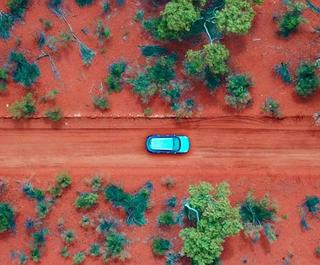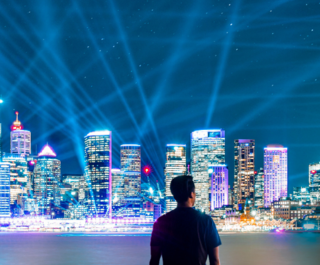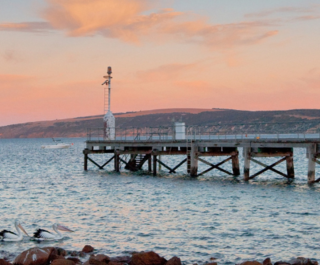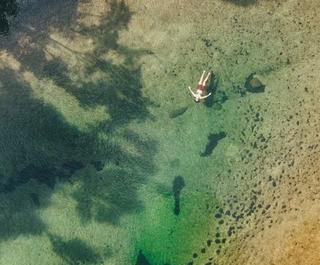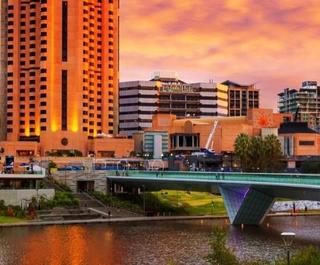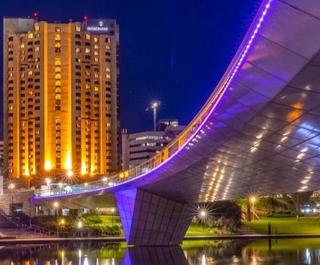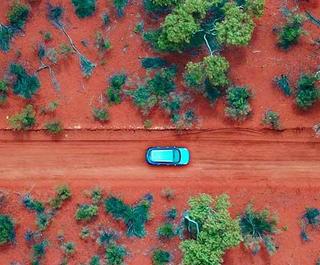
Underwater havens abundant in sea life, native creatures and cute critters, there's so much wildlife to find in Queensland. Attempting to discover it all can take you from one end of Australia's Sunshine State right up to the other end.
Nature encounters in Queensland provide an unforgettable adventure year-round. Get to know what wildlife you can see with this extensive guide.
.........................................................................................................................................................
Great Barrier Reef
.........................................................................................................................................................
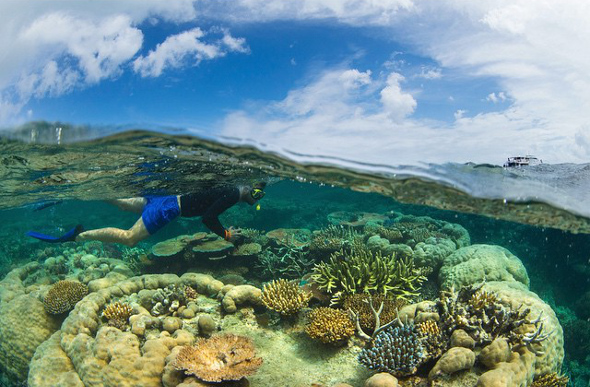 Snorkelling the Great Barrier Reef (image: @craigparryphotography).
Snorkelling the Great Barrier Reef (image: @craigparryphotography).
The Great Barrier Reef is one of the most impressive and diverse underwater expanses in the world, so it’s a no-brainer to snorkel and scuba dive the reef when in Queensland.
With over 1,800 species of fish (including the clownfish; better known as Disney's Nemo) and 350 types of coral, you could spend weeks, months or even years underwater and not see it all.
Day trips from one of Queensland’s many coastal centres such as Cairns, Port Douglas, Townsville, Airlie Beach and Bundaberg, are a popular option. For serious underwater enthusiasts, there are longer live-aboard dive trips available. Or you can head out on a glass-bottom boat to view the depths from above.
.........................................................................................................................................................
Koalas
.........................................................................................................................................................
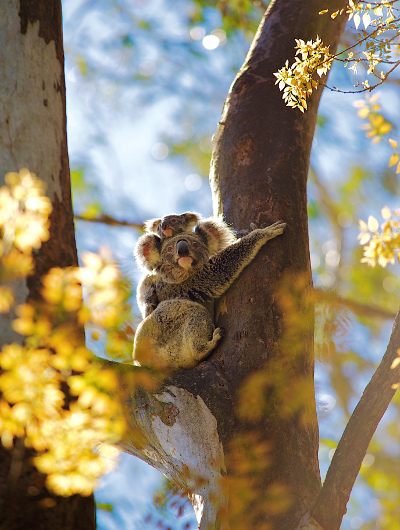 Koalas survey the landscape from the perch in the tree
Koalas survey the landscape from the perch in the tree
Queensland is one of only two states in Australia where visitors can cuddle a koala and there are plenty of locations to snag a snuggle.
The name koala is derived from an ancient Aboriginal word meaning ‘no drink', because koalas seldom drink (usually only during droughts or when sick) and receive most of their hydration from consuming gum leaves.
Native to Australia and famed across the globe, these marsupials are found in various habitats including the bush and coastal islands.
.........................................................................................................................................................
Cassowaries
.........................................................................................................................................................
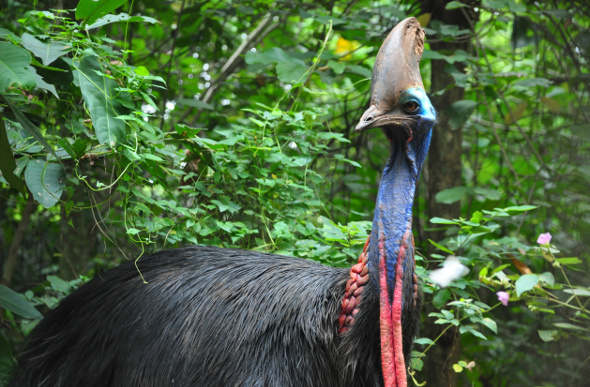 The colourful and giant Cassowary (image: Getty)
The colourful and giant Cassowary (image: Getty)
Australia’s heaviest flightless birds (cassowaries can grow to the same height as humans) are often spotted around the luscious rainforests of North Queensland.
If you don’t one in the wild, there are plenty of places in Queensland where you can get close to a cassowar, including at Daintree Wild Zoo, Johnstone River Crocodile Park in Innisfail and Birdworld Kuranda. These beautiful and unique birds are often distinguished by their coarse feathers and vivid blue necks.
.........................................................................................................................................................
Humpback Whales
.........................................................................................................................................................
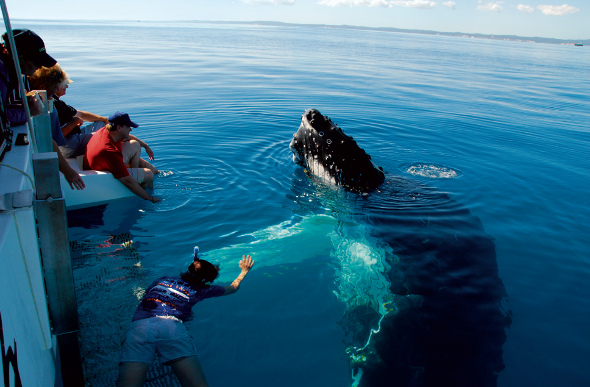 Swimming with humpback whales in Hervey Bay
Swimming with humpback whales in Hervey Bay
There’s something magnificent about witnessing a majestic humpback whale breach and slap its unusually long fins, and in Hervey Bay on the Fraser Coast (one of the only places in the world where whales come to rest and play) sightings are surefire from July to November.
There are a number of whale-watching tours available. Trips usually include expert commentary as well as specially designated sighting areas, spacious viewing decks and underwater viewing rooms, offering an intimate and unforgettable encounter.
.........................................................................................................................................................
Boyd Forest Dragons
.........................................................................................................................................................
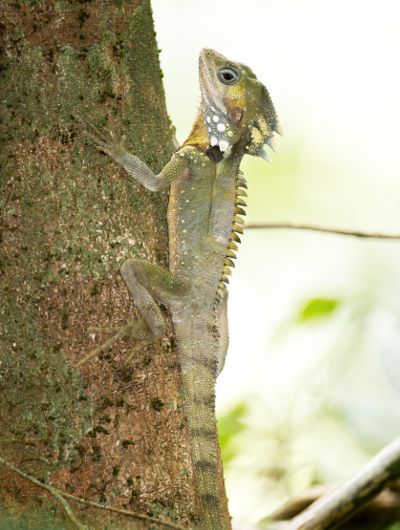 Can you spot it? The Boyd Forest Dragon does a good job of blending in with tree bark (image: Getty)
Can you spot it? The Boyd Forest Dragon does a good job of blending in with tree bark (image: Getty)
With jagged scales on a crest behind their head, the distinctive Boyd Forest Dragon can only be spotted in the rainforests of North Eastern Queensland, predominantly around Lake Eacham, Lake Barrine, Mossman Gorge and the Malanda Falls Environmental Park.
Sightings are special because the lizards spend most of their time perched in trees, rarely moving. They are of a similar colouring to tree bark, so they easily blend into the natural surrounds and are tricky to spot.
The best way to sight this rare creature is to walk slowly and scan tree trunks at about head height or lower, or by guided tour such as those led by a Mossman Gorge Indigenous guide.
Discover TNQ's secrets. 11 Hidden Secrets Of Tropical North Queensland
Hear it from the celebrities. What The Celebs REALLY Think About Queensland
.........................................................................................................................................................
Saltwater Crocodiles
.........................................................................................................................................................
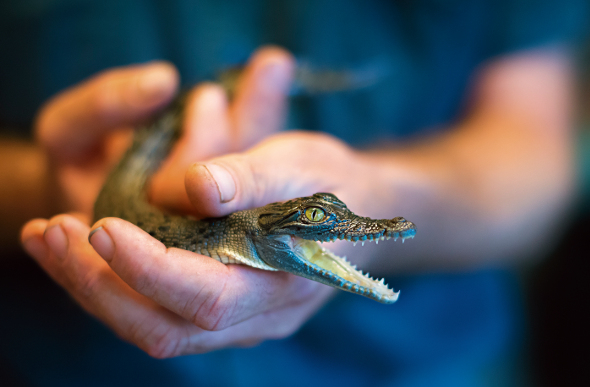 Even a baby crocodile looks cute
Even a baby crocodile looks cute
A full-grown saltwater crocodile is said to be the largest of all living reptiles, so it’s a fair assumption that most people prefer to meet these predators in captivity.
In Queensland there are many places to get close and personal, minus the danger. Take a Daintree River Cruise or a Hartley’s Crocodile Adventures Cruise in Tropical North Queensland; learn about crocs at the late Steve Irwin’s Australia Zoo on the Sunshine Coast; or if adventure is more your thing, zoom over the crocs at the Cairns Zoom and Wildlife Dome.
.........................................................................................................................................................
Turtles
.........................................................................................................................................................
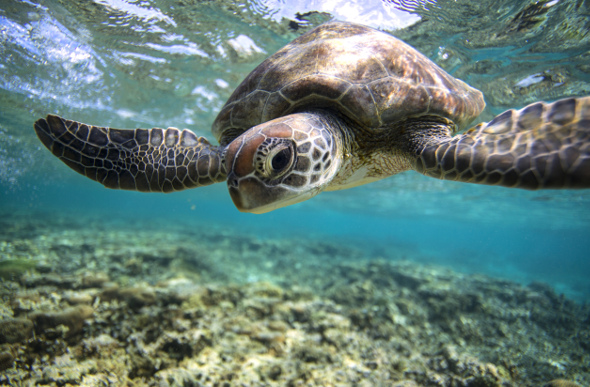 A turtle swimming off Lady Elliott (image: Getty)
A turtle swimming off Lady Elliott (image: Getty)
The Great Barrier Reef is home to six of the world’s seven turtle species, but it's the southern end that's a real hot spot for turtle sightings.
Swim, snorkel and play with turtles on Lady Musgrave, Lady Elliot and Heron Islands (waterproof cameras are a must) or head to Bundaberg’s Mon Repos Conservation Park between November and March to witness loggerhead, green, leatherback and flatback turtles lay and hatch their eggs – a truly memorable experience.
.........................................................................................................................................................
Wallabies
.........................................................................................................................................................
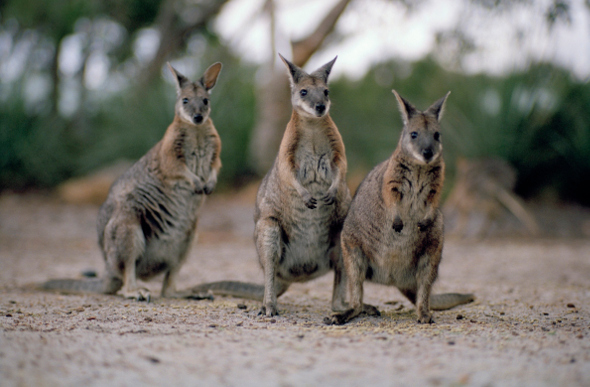 Three wallabies stand to attention (image: Getty)
Three wallabies stand to attention (image: Getty)
This cute, hoppy Australian marsupial is legendary across the world, but the best area to spot these unique creatures is at Cape Hillsborough National Park, located about 20 kilometres north of Mackay.
Wake up before sunrise and plant yourself on the beach next to the Cape Hillsborough Nature Tourist Park to witness the playful wallabies feed on the seedpods that have washed up onto the beach overnight.
The national park is also home to a colony of about 200 bats, providing an animal encounter for night owls.
.........................................................................................................................................................
Platypuses
.........................................................................................................................................................
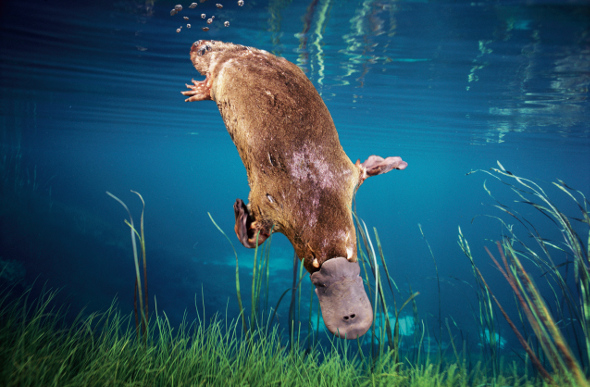 The platypus can be tough to see, but is well worth the time spent finding it
The platypus can be tough to see, but is well worth the time spent finding it
The platypus can be tricky to spot. The shy critter is quiet and typically spotted during sunrise and sunset.
Broken River in Mackay Eungella National Park (80 kilometres north west of Mackay) is recognised as one of the best regions to see the platypus and is currently undergoing a $600,000 Platypus Walk project, which will include new walkways and viewing areas.
These crafty creatures can also be seen at Paluma Range National Park, located between Ingham and Townsville in North Queensland, and at Carnarvon Gorge, west of Rockhampton.
.........................................................................................................................................................
Visit your local Flight Centre or call 131 600 for more advice and the latest deals on travelling to Queensland.
.........................................................................................................................................................




